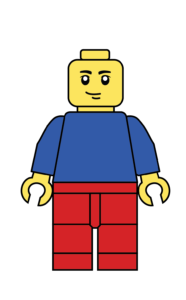Creating Characters That Are Uniquely Yours
By Megan Mestel, Student Contributor
Have you ever found yourself staring at your newest character you’ve created and can’t shake the feeling that you’ve seen them somewhere else before? No, I’m not talking about that one guy you saw at the grocery store that kind of looks like your mentor. I’m talking about how you suddenly realize you’re staring at your favorite TV show character, whose personality you’ve accidentally ripped off entirely. Just because you’ve stuck a new name on them like a “Hello, my name is:” sticker does not mean you’ve created a character that is uniquely yours. Lucky for us, there are a few tricks you can utilize so that your new character doesn’t just look like Bilbo Baggins with a fake mustache.
If you can create a character without taking ANY inspiration from ANYWHERE, then you, my friend, have a gift and you must share your secret with me. However, if you’re like me, all of your character ideas come from somewhere, whether it’s from a book, movie, show, your uncle’s neighbor’s third cousin, or even a song. Character inspiration can and does come from everywhere!
Now let’s get something straight here—I am not giving you permission to steal other people’s characters. But you can steal their hair.
That sounded odd… let me explain.
Imagine every character as a LEGO character: they all start out the same. Same empty yellow head, blank blue shirt, and plain red legs. No noticeable appearance, no differentiating personality: a perfectly blank idea. Everything else you do from here makes this character yours. The character’s appearance, personality, voice, quirks, and flaws are yours for the picking from anywhere you get inspiration from.
To make characters uniquely yours, you have to get your pieces from different places. Let’s say you want a character like Han Solo (who doesn’t?). We’ll call them Riley. If you make Riley look like Solo, act like Solo, sound like Solo… you’ve stolen Han Solo, and that’s not okay. Not only have you stolen someone else’s creation, you’ve also “created” a very predictable, un-unique character, because Solo is an old character and anyone who knows him will have a good idea of how he’ll react in any scenario.
This Riley character is going to stick around, so let’s make these LEGO pieces yours.
Personality & Voice – The Face
Outside of appearance, this is the best way to make characters differ from each other. Making different personalities for your character is pretty obvious, but what about voice? The secret to character voice is in sentence structure. If you have a bubbly character, they’re probably going to have long, run-on sentences that ramble from one thing to the next without much punctuation in between and with a whole lot of filler words (I mean a whole lot). Characters like these love commas, and they go just about anywhere the character needs to take a quick breath.
If you have an angsty character, your sentences will be short. To the point. Not much fluff. They don’t have much to say. If they do, they’re going to say it fast. Periods are their friends. Sometimes sentences like these don’t sound whole, but they work.
Alternatively, you might have a wise mentor character. They may use longer sentences–and interesting punctuation–but the sentences sound more complex and advanced when compared to the bubbly character. This voice sounds more like an English paper than a running commentary of an insane mind. Using more interesting punctuation like the : and the ; and the — can make their voice sound more mature.
Let’s go back to Riley. We want to keep them with the Han Solo personality–a cocky, reckless, sarcastic pilot. Unless they’re dropping a snappy sarcastic one-liner, they’re probably going to lean towards the “angsty” character voice type.
Appearance – The Hair
Obviously, we cannot have a character that acts like Solo AND looks like Solo. How can we make Riley act like Solo and still be unique? Two of the easiest tricks to do are gender-swapping and style-swapping. Let’s make Riley a girl who likes to wear vivid colors. We’ll give her blonde hair in a ponytail and a bright red leather jacket (that I’ve decided to borrow from Star-Lord). I’m also going to make her tall because I’m afraid of running into the “short snarky girl” stereotype.
Appearances are probably the easiest LEGO pieces to “borrow” from other forms of stories because writing isn’t a visual medium like filmmaking. See if you can guess what popular character I’m describing here.
Picture a character who is hairy. I mean very hairy–long hair all over their body. They’re a side character, and they kind of act as the “comic relief”. They’re the “weird uncle/cousin” of the group, clearly different from the rest of the cast. They typically only wear 1-2 pieces of clothing, and they do not speak English.
What character did you picture? If you’re thinking of Chewbacca… well, you’re wrong. I’m describing Cousin Itt from The Addams Family. Odds are, unless I’m very specific, you’re going to imagine someone else. So if you want a character that looks like Frodo, do it (just don’t make them act like Frodo, too).
Quirks – The Body
This is where you can really make your character uniquely yours. Give them something that makes them different. Maybe they collect feathers, rocks, or bottle caps. Maybe they don’t use contractions when they speak. Maybe they stutter, have an accent, or use a lot of witty comebacks.
The best way to make a character uniquely yours is to take your own quirks and spread them among your characters. Maybe your knee bounces while you sit, or you pick your fingernails. Maybe you unconsciously braid a piece of your hair when you’re worried–let’s give that one to Riley. We’ll know she’s nervous anytime we see a braid in her hair. It doesn’t matter how weird and obscure the quirk is–actually, that makes it more unique.
Flaws – The Legs
Last but not least, to fully develop a unique character, you need to give them flaws. It doesn’t matter if their flaw is personality-related, like their anger or stubbornness, or fear-related. The more flawed, the more human, the more relatable. If you can make a character that’s relatable, then your readers will bring their own experiences into the story, and that will make your character as unique as they can possibly be.
Riley, our tall, cocky pilot, is afraid of flying solo (see what I did there?). She’s about to go up for the first time, and her hair is full of tiny braids.
Now you have it: all of the LEGO building pieces you need to create a unique character. I can’t wait to read about them.
***
Where do you draw your character inspiration from the most often?
Megan Mestel is a storyteller in many different aspects of the word. With a major in animation and video game design, a love for filmmaking, and a passion for art alongside writing, she explores the limits of storytelling. An active member of the OYAN community since 2012, Megan is a mentor on the student forum. She spends her free time with her husband, Garrett, and her dog, Nori.









Thanks for it!
Thanks for this post, really useful!